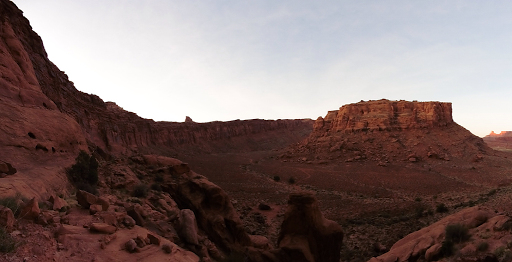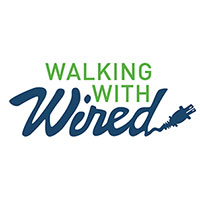Day 4: Heavy Loads & Dirt Roads
March 26th









Rim on Amasa Back Alt(38.4)- S of Canyonlands Overlook(57)
~18.6mi(GPS said 20mi)
It was a nice night last night and probably my best night of sleep thus far. It did seem to drop into the 30s, but not bad at all. By the time we got going just after 7am, it was comfortable in the 40s. We immediately had steep rocky switchbacks that took us down to a four wheel drive road. We stayed on 4WD roads all day! Here is a photo from the top of the switchbacks and the road we ended up on is in the center.

Days on roads are not uncommon out here and I’m used to them from the CDT. Sometimes walking on nice dirt roads can be like hiking on a really wide trail. On the Hayduke, it’s a nice break to get some quick miles in with little navigation or obstacles to interrupt the pacing.
It’s only our fourth day, so we are both still settling in on this hike. Physically, I am thankfully doing pretty well so far. I only have a few foot blisters, a slight heat rash on my hands, and sore shoulders from a heavy pack to deal with. Katherine has had some random ligament issues in her ankles and calves in the past year that are showing up a bit, so she’s taking preventative measures to ease into this hike and make sure not to push unnecessarily. She is making sure to stop and stretch regularly and is not pushing the pace or mileage. We both came into this hike with a habit of pushing on hikes, but we are both consciously trying not to do that here. The water on the Hayduke will dictate much of our general strategy, but overall, we are making a concerted effort not to push. The Hayduke isn’t a big mile trail and it is usually a 1-2mi/hr pace. For the most part, we have a baseline goal of 15mi/day…or a 15mi average. Due to camping restrictions and terrain, there will be somedays where mileage will be much less or more, but it averages out. The mileage on the Hayduke maps are not exact and can be off in either direction. Katherine is helping to update the maps, so she is tracking our whole route on her GPS and we can see how far we’ve gone. I’ll be noting both map mileage and GPS mileage on the blog so people can get an idea of what we walked vs what the maps have. Regardless, this trail will be low mileage days (though no less exhaustung) and few days will be over 20mi. We looked ahead to the next 8 days and it’s nice to know mileages won’t require super long days.

The morning went by ok with nice scenery. I listened to more of the audiobook Tracks and am enjoying it. The first half of the day was near an outdoor adventure place, so we had fairly consistent traffic of jeeps, dune buggies, and dirt bike motorcycles…ah, nature! It was very temping to give our heavy packs and/or water to them to have them shuttle it down the road a few miles, but we resisted.

We arrived at our one water source (on the Colorado River) for the day at lunch. The next 100% reliable source will be ~30 miles away. There is a possible source ~20mi away (rated 2 for reliability out of 4) that we hope to hit at lunch tomorrow, but we are carrying as if it will be a 30mi carry. Given the conservative miles we’re doing, that means we may go the second half of the day today and all day tomorrow on one long carry until we reach water the third day in the morning. Thankfully the heat hasn’t set in and it’s been fairly relaxed miles. Katherine and I vary greatly in how much water we drink as she drinks way more than I do. She chose to carry a whopping 7L (14lbs!) and I took 5L (10lbs), which I know isn’t much for more than a day and a half, but it’s really how much I tend to drink. To add to the fun, the source was the Colorado River and it was horribly disgusting. Here’s the source which was like green sludge. Tons of things floating in it, and yes, you can clearly see the cow droppings all along the beach.

I was very happy to have my new Sawyer Squeeze to filter that water! The water is also slightly alkaline like much of the sources out here, so we are both waiting to see if we have a digestive reaction yet as the higher alkaline sources can really go right through you…

We chose to cook our dinners for lunch at the source so we wouldn’t have to carry extra to cook at the end of the day. It was enjoyable and we took about 1.5hrs there. Thanks to Glenn and Carol for my first Mtn House meal of the trip! This will happen many times on this trail where our dinners will be lunch at a water source so we can cook, and then lunches will be our dinners. It’s in the 70s and warming to upper 70’s today, but still not bad thankfully. The day went by kinda slow with the road walk and very heavy packs. Definite bonding over our shared discomforts and laughing at the fact that we voluntarily signed up for such a feat that will recur many times in the next two months. I used my umbrella to stay extra protected from the sun today, and loved it! I had to adjust the hands free rigging now that my pack is about level with my head. Here is a photo before the adjustment with me carrying 5L along with 8 days of food in my Gossamer Gear Mariposa pack. Love it!

The second half of the day was pretty quiet away from the annoying traffic of the morning. We are still getting to know one another and it was a good opportunity to talk about things other than navigation and logistics. The miles came pretty slowly as it was slow going with such heavy packs and sometimes loose dirt and rock terrain. We each had good slides down onto our packs with some loose rocks on hills. The road went through some tighter canyons a bit and that was cool.

We decided to stop at 6pm enjoying the relaxed approach and both happy to get the packs off for the night. It’s a good way to ease into the hike and I really hope Katherine’s ankles and calves adjust so she can hike more enjoyably. My shoulders are the only thing that’s sore other than my feet. My feet are having regular swelling and adjustment to hiking with a heavy pack all day. I tend to get blisters and calluses on my pinky toes and I have one that I didn’t feel but noticed at lunch that I popped. It was fine all day and I was surprised to see how big it was at the end of the day. It was like a double fat toe. I had to take pictures of course. It turned out to have formed under the callus I already had, so more surgery was needed than usual and I was happy to have extra time at camp to pop it and cut the callus off, so it looks like it should do better tomorrow. Good times.

Our campsite is great and again the sand is too shallow to get stakes in, so Katherine is cowboying out under the stars. I am proudly putting my skills to use to pitch my non freestanding tent using heavy rocks to wedge stakes between. Again, it’s late and I’m dozing off…ready for another day of more road walking tomorrow!










Wired! I’ve been greatly inspired by your adventures and wonderful writing so generously shared with the hiking community. I’m planning to jump on the Arizona Trail this fall (2020) and tentatively on the Hayduke in March 2021. I was looking for a partner to join on the Hayduke, however, I can’t rely on anyone, and find that my hiking style of crushing large distances in a day is not most hiker’s agendas. I understand that the Hayduke is much more challenging terrain and navigation wise for big mile days, however, when pace is affected, I simply increase hiking time to achieve my distance using the beloved headlamp. Anyway, I do plan to peruse your entire blog on the Hayduke AND sift out the important data from Mitchell and Coronella’s HDT book while studying Skurka’s map bundle. I plan to do a rigorous study of this route to get familiar with the most challenging areas and the best egress in the event of an emergency. I will be taking my Garmin Inreach as my hiking partner. I would like to shoot you a few questions on the the areas with the longest runs between reliable water and resupply strategies without having to cache. I recall that you said if you did this route again that you would set caches. It seems like a large time and expense investment, particularly since you would need to retrace your route after the hike to pick up left behind rubbish AND there is a large possibility of never making it to your cache due to weather, injuries, etc. I’ve been vacillating on whether to cache or not but am currently thinking I’ll pack light on food, carry a larger capacity for long water carries, and move at a swifter pace with less weight. I’ve never been a fan of carrying huge loads on my shoulders since my packing days in the 1970’s. I will flick you some questions as I get deeper into my studies and preparation of this route.
With your hiking style, I’m sure you won’t have a problem of doing it without caching. Be sure to check out some of the more current blogs as well. There have been many updates particularly with resupply locations and places to send resupply packages that seem to make it much more streamlined as well.